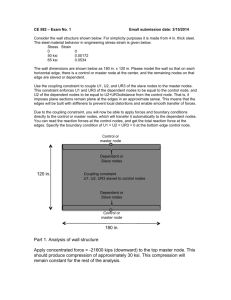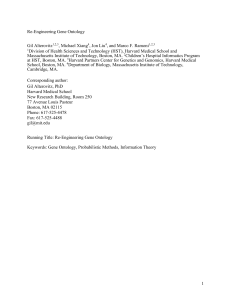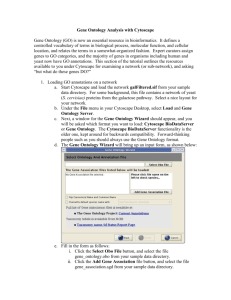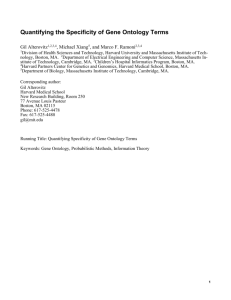Improving the Gene Ontology – Abstract Methods
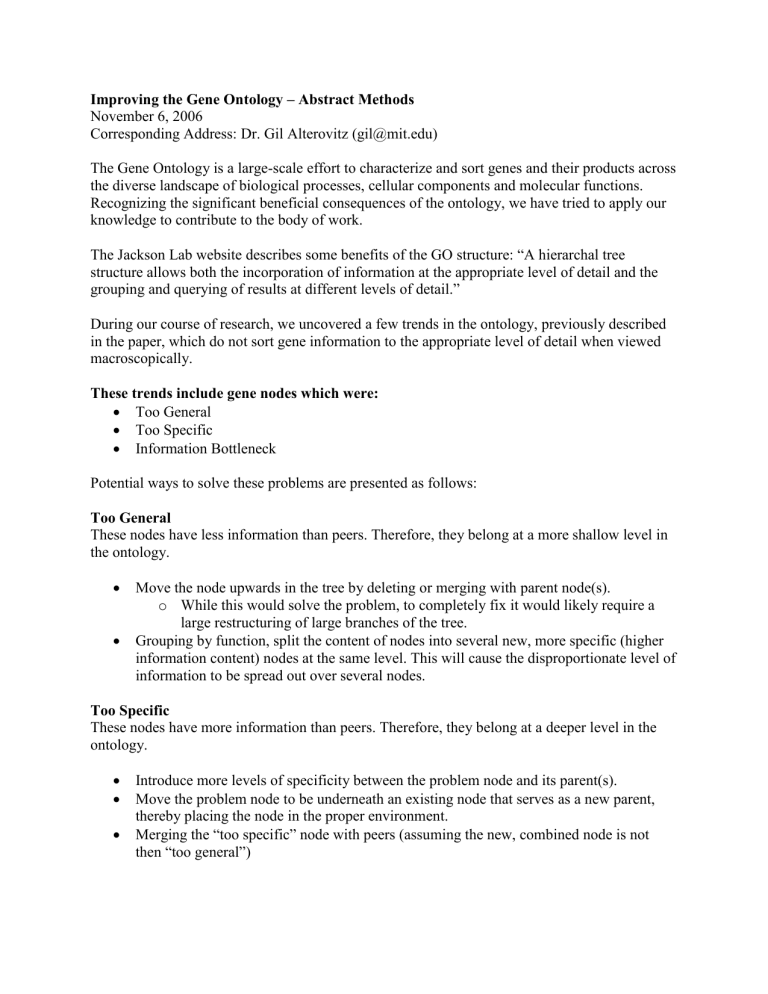
Improving the Gene Ontology – Abstract Methods
November 6, 2006
Corresponding Address: Dr. Gil Alterovitz (gil@mit.edu)
The Gene Ontology is a large-scale effort to characterize and sort genes and their products across the diverse landscape of biological processes, cellular components and molecular functions.
Recognizing the significant beneficial consequences of the ontology, we have tried to apply our knowledge to contribute to the body of work.
The Jackson Lab website describes some benefits of the GO structure: “A hierarchal tree structure allows both the incorporation of information at the appropriate level of detail and the grouping and querying of results at different levels of detail.”
During our course of research, we uncovered a few trends in the ontology, previously described in the paper, which do not sort gene information to the appropriate level of detail when viewed macroscopically.
These trends include gene nodes which were:
Too General
Too Specific
Information Bottleneck
Potential ways to solve these problems are presented as follows:
Too General
These nodes have less information than peers. Therefore, they belong at a more shallow level in the ontology.
Move the node upwards in the tree by deleting or merging with parent node(s). o While this would solve the problem, to completely fix it would likely require a large restructuring of large branches of the tree.
Grouping by function, split the content of nodes into several new, more specific (higher information content) nodes at the same level. This will cause the disproportionate level of information to be spread out over several nodes.
Too Specific
These nodes have more information than peers. Therefore, they belong at a deeper level in the ontology.
Introduce more levels of specificity between the problem node and its parent(s).
Move the problem node to be underneath an existing node that serves as a new parent, thereby placing the node in the proper environment.
Merging the “too specific” node with peers (assuming the new, combined node is not then “too general”)
Information Bottleneck
A dramatic drop-off in information contained in a particular level. For example: if level 12 had information content 12, level 13 had information of 10, and level 14 had information of 14, we would have to increase the information level of level 13. Information bottlenecks occur when too few nodes from one level transmit a disproportionate amount of information to the next level.
Solutions include increasing the information content of the problem level (here, level 13) and changing the GO structure so that more nodes transmit information from level 12 to 13.
Move nodes of high information content from the parent level (12) down to the problem level (13). Do this by either: o Finding an appropriate existing node in level 12 under which to place the parent node (thus moving the parent node to level 13) or o Creating a new node between the node and its parent to push the high information content node down to level 13
Adding child nodes to the parent level nodes (12)
Bringing information-rich nodes from the level below the bottleneck (here, level 14) up a level so that it adds information to the problem level. Do this by: o Deleting or moving up a parent node; or merging the ancestors in levels 12 and 13 to bring the level 14 node up to level 13.





